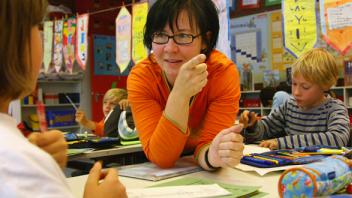Literacy programs: choose wisely and be picky
The 2017 National Assessment of Educational Progress (NAEP) report indicates that, as a whole, students in 4th, 8th, and 12th grades are not demonstrating marked growth in reading, with scores for disadvantaged students registering lower than in previous years (National Center for Education Statistics, 2017). Though research tells us that most students are fully capable of learning to be competent readers, regardless of their background (Lyon, 2002; Shaywitz, 2003), many teachers in the field have not been offered training in effective, developmental literacy instruction.
Many literacy programs have been developed with the goal of closing the literacy achievement gap, and there are currently hundreds of programs being implemented in schools across the nation. While many of these programs arm teachers with effective instructional materials, it is very important to remember that students learn through effective teaching, not through programs. Therefore, it is incumbent upon classroom teachers and school administrators to be able to discern the strengths and weaknesses of the plethora of literacy programs that are currently being marketed.
While there is not a specific program that will meet the developmental literacy needs of every child in a classroom, educators who are knowledgeable and picky will find that most programs offer some materials that may prove effective for one or more of their students. To instruct literacy in a way that enables all students to succeed, teachers need to have access to the research on literacy programs and use that knowledge to guide their selection of programs (or program components), strategies, and pedagogical approaches (McCardle & Chhabra, 2004; Stanovich & Stanovich, 2003).
The two most important considerations that educators need to keep in mind when evaluating literacy programs are:
- What are my students’ specific needs in reading, writing, vocabulary, and word knowledge? What do their literacy assessments tell me in terms of their strengths and weaknesses and how can I use these materials to meet my students’ needs and enhance their strengths?
- There is no such thing as a “magic bullet” program. There is no program in existence that will fully meet the literacy needs of every student in a given classroom. However, many programs offer components that, when matched with students’ needs, can be combined and implemented in ways that will result in reading growth.
Curriculum Evaluation Tool
This curriculum evaluation tool from The Reading League features components that align with the Simple View of Reading (Gough & Tunmer, 1986) and Scarborough’s Rope (Scarborough, 2001). Word recognition and language comprehension are broken down into subcomponents, and writing, spelling, and assessment are included as well. “Green flags” indicate practices that are aligned with evidence-based instruction. “Red flags” indicate practices that are not aligned with evidence-based instruction.
Literacy programs evaluation
Effective reading instruction includes targeted teaching of phonemic awareness and/or phonics (depending on the students’ needs and grade level), fluency, vocabulary, and reading comprehension strategies (Lyon et al., 2001; Torgesen, 2002).
The resources below provide independent reviews of the most well-known commercially available literacy programs currently used in U.S. classrooms. The reviews go into detail on components of the programs and comparative evidence of effectiveness. You can filter by grade, skill, intervention, support for special student populations, and more.
Literacy expert Tim Shanahan addresses the validity of third-party reading program reviews in his blog post, What About the Textbook Reviews? Shanahan identifies six problems with these reviews and suggests solutions to each.
What Works Clearinghouse
From the Institute of Education Sciences at the U.S. Department of Education, the What Works Clearinghouse (WWC) is trusted source of scientific evidence on literacy programs and products. WWC reviews the research, determines which studies meet rigorous standards, summarizes the findings, and allows you to compare different programs based on many parameters.
Best Evidence Encyclopedia
The Best Evidence Encyclopedia (BEE) is a free resource created by the Johns Hopkins University School of Education’s Center for Research and Reform in Education. It gives educators and researchers information about the strength of the evidence supporting a variety of programs available for students in grades K-12. The BEE mostly consists of systematic meta-analyses of research on effective programs.
Evidence for ESSA
Evidence for ESSA helps you find evidence-based reading programs that match your state, district, school, or classroom needs while meeting the ESSA evidence standards. ESSA (Every Student Succeeds Act) is the main federal law governing K-12 education.
About the author
Courtneay Kelly has worked as an elementary school teacher, a literacy specialist, a reading intervention specialist, and an education professor. She received a B.A in English Literature and a PreK-6 teaching licensure from Mary Washington, an M.Ed in Reading Education from the University of Virginia, and an Ed.D. in Curriculum & Instruction from the University of Virginia. She is an active researcher and is passionate about bridging the gap between current research and classroom practices. Currently, she is an assistant professor in the education program at Longwood University and enjoys consulting with local school districts and educators on effective literacy instruction.
